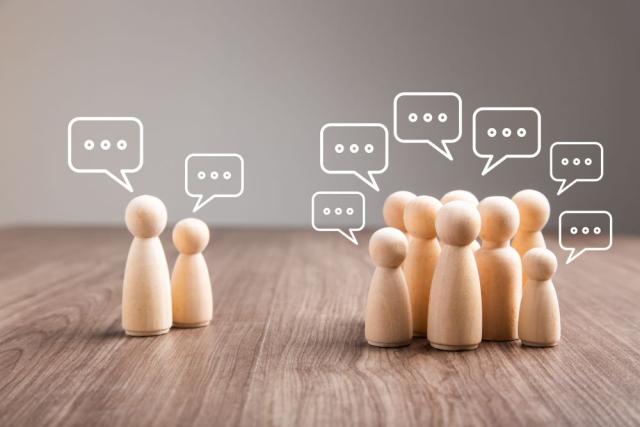
Based on the From Debate to Dialogue Training Series created by OAA Inclusive Excellence Education Program and the Michael V. Drake Institute for Teaching and Learning.
Personal preparation is key to navigating difficult conversations when they arise, be it the workplace, the classroom, or the residence hall. Dialogue is the fabric of human interaction and learning, and we also know that sharing diverse perspectives must be done with respect and care for everyone. While we hope you can join us for a training, this page offers a summary of the key skills from the workshop that you can use today as you strive to build respectful dialogue with your colleagues, classmates, friends, and family.
Want to learn more and practice these skills? Join us for our next training session.
Debate vs Dialogue
What is the difference between debate and dialogue?
Debate tends to be oppositional. Whether it’s a formal setting, like a staged debate, or any conversation we engage in interpersonally, the goal of debate is to take a side and establish your position as the winning argument. The primary goal of debate is to be right by highlighting the flaws in another person’s position. It can often set the stage for defensiveness and limits our ability to see other perspectives or think critically about ourselves and our actions. This is because debate keeps us in a head space of analyzing someone else’s position rather than understanding it.
Dialogue is about reaching understanding as opposed to agreement on which position is right. Dialogue doesn’t mean anyone has to abandon their viewpoint or that one position is right or wrong. Dialogue is a collaborative exploration of knowledge and experience. When we engage in dialogue, we lean into reflection and introspection by actively listening and suspending our judgement. The primary goal is learning about our perspectives and growing together.
Why do we want to engage in dialogue?
It’s important to find your own “why” for engaging in dialogue. Our shared values encourage us to engage in dialogue. Dialogue helps us to broaden our own perspectives and learn more about the people around us. A productive dialogue can strengthen relationships by building trust and respect across differences as we demonstrate empathy and understanding for each other’s perspectives.
Creating Space for Dialogue
The following dialogic skills will help you navigate difficult conversations and support students, staff, or faculty as they engage in discussions on challenging topics. Model and/or share these skills with your students and colleagues.
What skills can I use to build dialogue?
Perspective Taking – Ask yourself what we may or may not know about someone else’s experience and identities. Be curious about viewpoints and perspectives. Become aware of our judgements and push pause on them. Seek understanding through actively listening.
Reflective Listening – Actively listen to learn about the other person’s viewpoint and then reflect back what you’ve learned. This will allow you to confirm understanding and demonstrate your commitment to the conversation. “What I hear you saying is… did I get that right?”
Respectful Inquiry – Ask clarifying questions after you reflect what you’ve learned. “Can you share more?” “What did you mean when you by this?” Respectful inquiry actively expresses that you want to learn more about others and their experiences.
Affirming Language – Affirming language let’s the other person know that you appreciate their vulnerability and willingness to participate in dialogue with you. Phrases like “thank you for sharing that with me,” demonstrate that you care about the other person and value their knowledge and experience. Affirming language can also hold two truths at the same time. Using “and” instead of “but” can be a powerful signal to others that we hear what they are saying and would like to offer something additional to the conversation.
How can I create a sense of safety when engaging in dialogue around difficult topics?
One way to do this is by identifying our learning edges.
Comfort Zone – When we feel most at ease. The conversation aligns with what we know or have experienced. It doesn’t challenge our own thinking.
Learning Zone – Conversations that challenge our understanding. Sometimes at our learning edge, we experience discomfort or other emotions as we wrestle with new ideas that put our own into question. This can be a space of productive conflict when we are open to understanding and learning.
Danger Zone – When new information causes strong feelings, an unexpected intense emotional response, or feels harmful. This can push us into debate.
Being aware of our comfort zone, learning edges, and danger zone can help us navigate through dialogue and make decisions about how to handle challenging conversations.
Other strategies for creating safety in dialogue include:
- setting community agreements and returning to them when conversations becoming challenging
- Individual personal reflection before starting a challenging dialogue
- Providing platforms like Mentimeter to create anonymous opportunities for sharing.
- Modeling dialogic skills and encouraging others to follow your lead.
What do I do if a conversation shifts toward debate? How can I shift towards dialogue?
Redirecting Strategies
- Respectful Inquiry – ask clarifying questions
- Review the community agreements
- Utilize the dialogic skill of perspective taking – reduce judgement and seek to understand
- Use reflective listening
- Share your perspective using “I” statements
What do I do if the conversation becomes heated, triggering, or hits the danger zone?
- Acknowledge the tension and indicate that you need to take a break.
- Ask to pause the conversation and return at another time.
- Speak openly. Share what you are feeling.
- Use the language of learning zones. Acknowledge that the conversation is feeling harmful, or is entering the danger zone, and that you need to step away.
Interested in learning and practicing dialogue skills in real time? Register for one of our From Debate to Dialogue trainings.
Resources
There are additional resources across campus to supplement your learning: